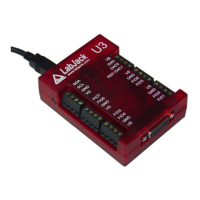Another variation is a 4-wire sensor where there are two signal wires (positive and negative)
does not work is a bridge type sensor, such as pressure
ensor, providing the raw bridge output (and no amplifier). In this case the signal voltage is the
d
o the ground
ire, but the complication is what is the voltage of the box ground compared to the LabJack
round.
d to AINx and GND on the LabJack.
d
ot want
m flowing on the ground. Use a small wattage
sistor (typically 1/8 or 1/4 watt) so that it blows if too much current does flow. The only
s on
for
,
e voltage of each signal wire before connecting to the U3.
ame
wire would be connected
a 100 Ω resistor which is connected to U3 ground.
lified before connecting to the LabJack.
rather than one. If the negative signal is the same as power ground, or can be shorted ground,
then the positive signal can be connected to AIN and a single-ended measurement can be
made. A typical example where this
s
difference between the positive and negative signal, and the negative signal cannot be shorte
to ground. Such a signal could be measured using a differential input on the U3.
2.6.3.4 Signal powered externally
An example is a box with a wire coming out that is defined as a 0-5 volt analog signal and a
second wire labeled as ground. The signal is known to have 0-5 volts compared t
w
g
If the box is known to be electrically isolated from the LabJack, the box ground can simply be
connected to LabJack GND. An example would be if the box was plastic, powered by an
internal battery, and does not have any wires besides the signal and ground which are
connecte
If the box ground is known to be the same as the LabJack GND, then perhaps only the one
signal wire needs to be connected to the LabJack, but it generally does not hurt to go ahea
and connect the ground wire to LabJack GND with a 100 Ω resistor. You definitely do n
to connect the grounds without a resistor.
If little is known about the box ground, a DMM can be used to measure the voltage of box
ground compared to LabJack GND. As long as an extreme voltage is not measured, it is
generally OK to connect the box ground to LabJack GND, but it is a good idea to put in a 100 Ω
series resistor to prevent large currents fro
re
current that should flow on the ground is the return of the analog input bias current, which i
the order of … for the U3.
The SGND terminal (on the same terminal block as SDA/SCL) can be used instead of GND
externally powered signals. A series resistor is not needed as SGND is fused to prevent
overcurrent, but a resistor will eliminate confusion that can be caused if the fuse is tripping and
resetting.
In general, if there is uncertainty, a good approach is to use a DMM to measure the voltage on
each signal/ground wire without any connections to the U3. If no large voltages are noted
connect the ground to U3 SGND with a 100 Ω series resistor. Then again use the DMM to
measure th
Another good general rule is to use the minimum number of ground connections. For instance,
if connecting 8 sensors powered by the same external supply, or otherwise referred to the s
external ground, only a single ground connection is needed to the U3. Perhaps the ground
leads from the 8 sensors would be twisted together, and then a single
to
2.6.3.5 Amplifying small signal voltages
The best results are generally obtained when a signal voltage spans the full analog input range
of the LabJack. If the signal is too small it can be amp
19

